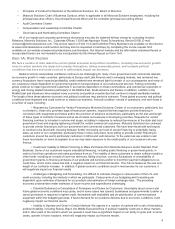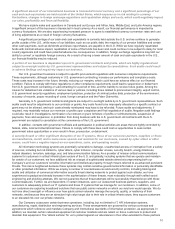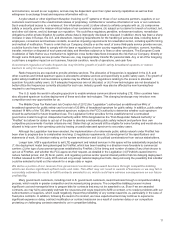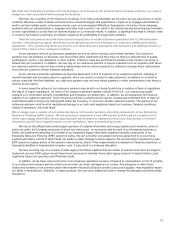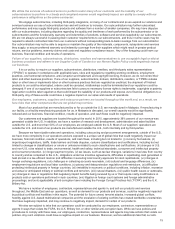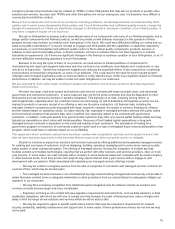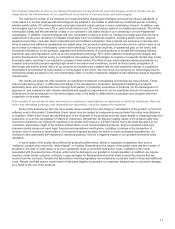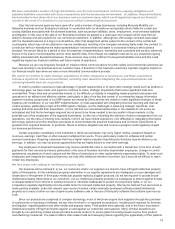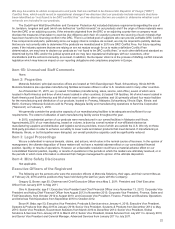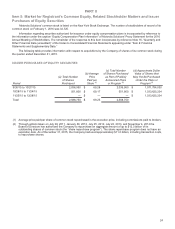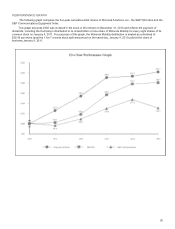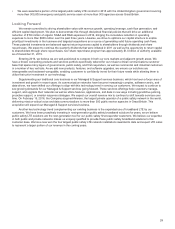Motorola 2015 Annual Report Download - page 20
Download and view the complete annual report
Please find page 20 of the 2015 Motorola annual report below. You can navigate through the pages in the report by either clicking on the pages listed below, or by using the keyword search tool below to find specific information within the annual report.19
to our products, seeking a percentage of sales as licenses fees, seeking injunctions to pressure us into taking a license, or a
combination thereof. Defending claims may be expensive and divert the time and efforts of our management and employees.
Increasingly, third-parties have sought broad injunctive relief which could limit our ability to sell our products in the U.S. or
elsewhere with intellectual property subject to the claims. If we do not succeed in any such litigation, we could be required to
expend significant resources to pay damages, develop non-infringing products or to obtain licenses to the intellectual property
that is the subject of such litigation, each of which could have a negative impact on our financial results. However, we cannot be
certain that any such licenses, if available at all, will be available to us on commercially reasonable terms. In some cases, we
might be forced to stop delivering certain products if we or our customer or supplier are subject to a final injunction.
We attempt to negotiate favorable intellectual property indemnities with our suppliers for infringement of third-party
intellectual property rights. However, there is no assurance that we will be successful in our negotiations or that a supplier's
indemnity will cover all damages and losses suffered by us and our customers due to the infringing products or that a supplier
will choose to accept a license or modify or replace its products with non-infringing products which would otherwise mitigate
such damages and losses. Further, we may not be able to participate in intellectual property litigation involving a supplier and
may not be able to influence any ultimate resolution or outcome that may negatively impact our sales if a court enters an
injunction that enjoins the supplier's products or if the International Trade Commission issues an exclusionary order that blocks
our products from importation into the U.S. Intellectual property disputes involving our suppliers have resulted in our involvement
in International Trade Commission proceedings from time to time. These proceedings are costly and entail the risk that we will
be subjected to a ban on the importation of our products into the U.S. solely as a result of our use of a supplier's components.
In addition, our customers increasingly demand that we indemnify them broadly from all damages and losses resulting
from intellectual property litigation against them. These demands stem from the increasing trend of the non-practicing entities
that engage in patent enforcement and litigation targeting the end users of our products. End users are targeted so the non-
practicing entities can seek royalties and litigation judgments in proportion to the value of the use of our products, rather than in
proportion to the cost of our products. Such demands can amount to many times the selling price of our products.
Our patent and other intellectual property rights are important competitive tools and may generate income under license
agreements. We regard our intellectual property as proprietary and attempt to protect it with patents, copyrights, trademarks,
trade secret laws, confidentiality agreements and other methods. We also generally restrict access to and distribution of our
proprietary information. Despite these precautions, it may be possible for a third-party to obtain and use our proprietary
information or develop similar technology independently. In addition, effective patent, copyright, trademark and trade secret
protection may be unavailable or limited in certain foreign countries. Unauthorized use of our intellectual property rights by third-
parties and the cost of any litigation necessary to enforce our intellectual property rights could have a negative impact on our
financial results.
As we expand our business, including through acquisitions, and compete with new competitors in new markets, the
breadth and strength of our intellectual property portfolio in those new markets may not be as developed as in our longer-
standing businesses. This may expose us to a heightened risk of litigation and other challenges from competitors in these new
markets. Further, competitors may be able to negotiate significantly more favorable terms for licensed intellectual property than
we are able to, which puts them at a competitive advantage.
Tax matters could have a negative impact on our financial condition and results of operations.
We are subject to income taxes in the U.S. and numerous foreign tax jurisdictions. Our provision for income taxes and
cash tax liability may be negatively impacted by: (i) changes in the mix of earnings taxable in jurisdictions with different statutory
tax rates, (ii) changes in tax laws and accounting principles, (iii) changes in the valuation of our deferred tax assets and
liabilities, (iv) failure to meet commitments under tax incentive agreements, (v) discovery of new information during the course of
tax return preparation, (vi) increases in nondeductible expenses, or (vii) difficulties in repatriating cash held abroad in a tax-
efficient manner.
Tax audits may also negatively impact our business, financial condition and results of operations. We are subject to
continued examination of our income tax returns, and tax authorities may disagree with our tax positions and assess additional
tax. We regularly evaluate the likelihood of adverse outcomes resulting from these examinations to determine the adequacy of
our provision for income taxes. There can be no assurance that the outcomes from these continuing examinations will not have
a negative impact on our future financial condition and operating results.
Our success depends in part upon our ability to attract, retain and prepare succession plans for senior management
and key employees.
The performance of our CEO, senior management and other key employees is critical to our success. If we are unable to
retain talented, highly qualified senior management and other key employees or attract them when needed, it could negatively
impact our business. We rely on the experience of our senior management, most of whom have been with the Company for
many years and as a result have specific knowledge relating to us and our industry that is difficult to replace and competition for
management with experience in the communications industry is intense. A loss of the CEO, a member of senior management or
key employee particularly to a competitor could also place us at a competitive disadvantage. Further, if we fail to adequately plan
for the succession of our CEO, senior management and other key employees, our business could be negatively impacted.


